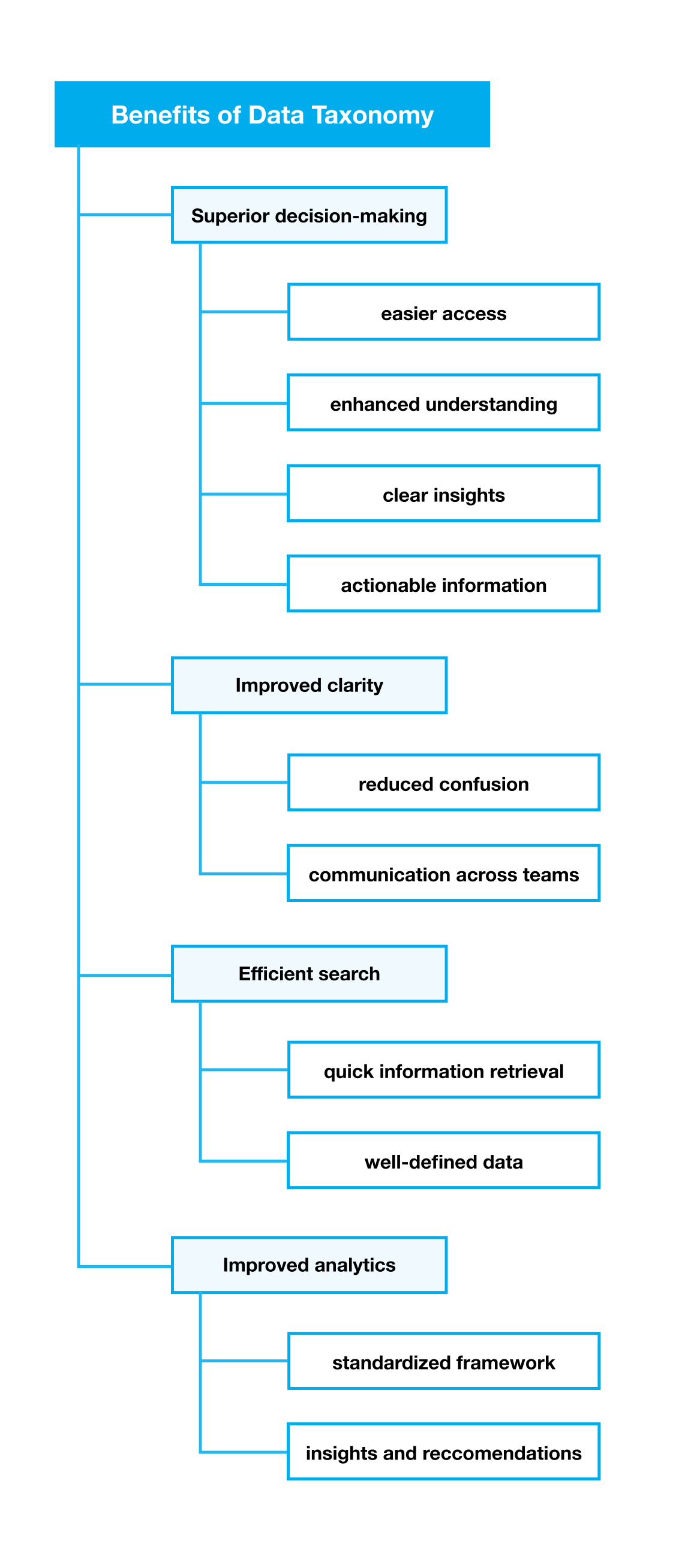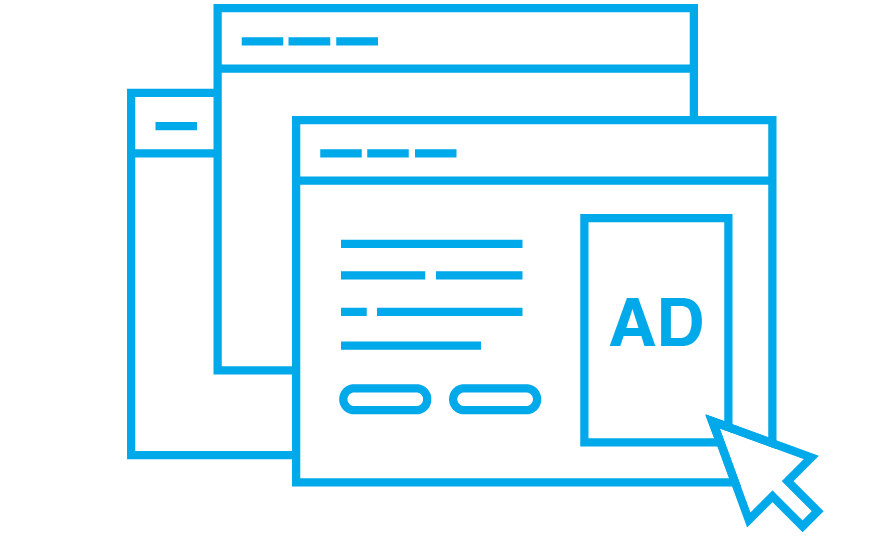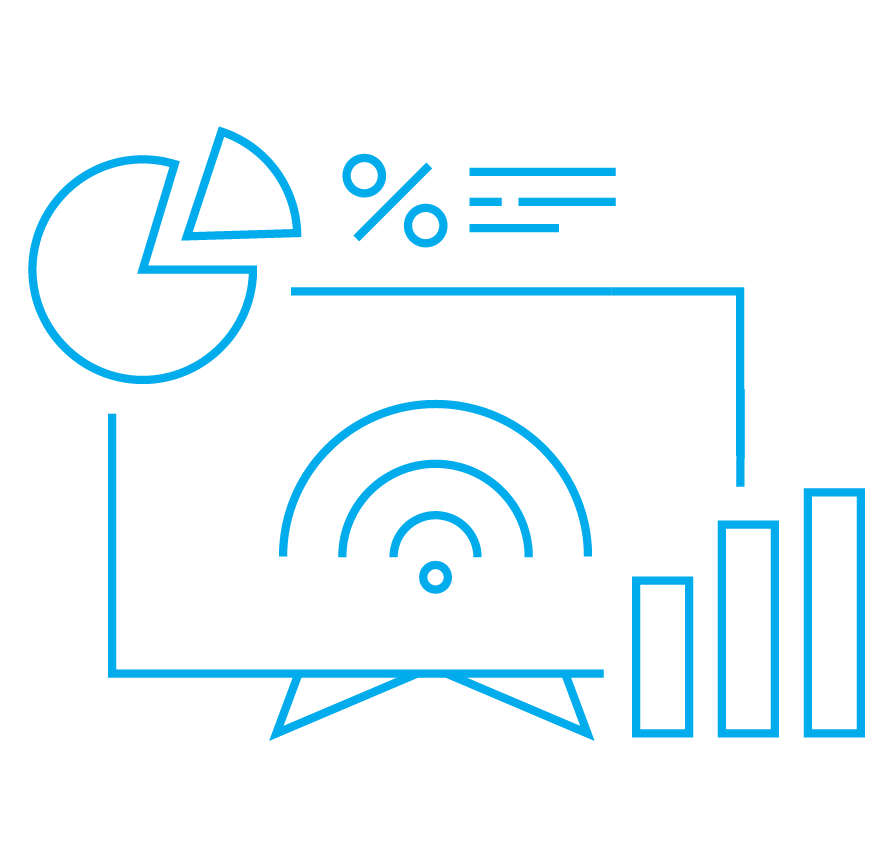- What is Data Taxonomy?
- What is the objective of data taxonomy?
- What features does a Data Taxonomy have?
- What is a Data Taxonomy example?
- What are the benefits of Data Taxonomy?
- What industries use Data Taxonomies on a daily basis?
- What are the Data Taxonomies at OnAudience?
- Where Custom Data Taxonomies can be activated?
What is Data Taxonomy?
Data taxonomy is a method of sorting and grouping data into different categories and subcategories based on their similarities. It helps in organizing information in a structured way by creating a hierarchical structure and following specific guidelines to classify and label objects within a specific field of knowledge.
In simpler terms, data taxonomy is like creating a well-organized filing system for data, making it easier to find and understand.
What is the objective of data taxonomy?
The purpose of a data taxonomy is to improve data organization, quality, and governance by providing a consistent framework for data classification. It also serves as a reference point for integrating different business systems and can be utilized to curate information and guide machine learning processes. Implementing a data taxonomy promotes clarity, communication, and better decision-making in data management.
What features does a Data Taxonomy have?
A taxonomy typically has the following features:
- Hierarchy – a hierarchical structure, with categories and subcategories organized in a logical and structured manner.
- Classification – data is classified based on similar characteristics, grouping related items together.
- Organization – large amounts of data are organized and categorized which makes it easier to navigate and locate specific information.
- Standardization – provides a standardized framework for organizing data, ensuring consistency and uniformity across different systems and applications.
- Flexibility – can be customized and adapted to suit specific needs and requirements, allowing for flexibility in organizing and classifying data.
- Searchability – enables efficient searching and retrieval of data, as they provide a structured framework for organizing information.
- Scalability – can accommodate the growth and expansion of data over time, allowing for the addition of new categories and subcategories as needed.
- Integration – Taxonomies can be integrated with other systems and applications, enabling seamless data sharing and interoperability.
Overall, taxonomies provide a structured and organized approach to data management, facilitating effective data organization, retrieval, and analysis.
What is a Data Taxonomy example?
To better comprehend the workings of data taxonomy, let’s examine a practical illustration concerning sports and different football teams.

What are the benefits of Data Taxonomy?
Data taxonomy offers several benefits some of the key benefits include:

- Better Decision-Making – Helps in organizing and classifying data, making it easier to access and understand. It enables better decision-making by providing clear insights and actionable information.
- Improved Clarity and Communication – With a standardized taxonomy, the meaning and sources of data become clearer, reducing confusion and improving communication across teams and departments.
- Enhanced Data Quality – Data taxonomy ensures consistent naming conventions and definitions, which improves data quality. It helps in avoiding duplication and maintaining data integrity.
- Efficient Search Capabilities – A well-defined data taxonomy enhances search capabilities, allowing users to quickly locate and retrieve relevant information.
- Better Analytics and Insights – By standardizing data inputs and outputs, data taxonomy enables improved analytics, insights, and recommendations. It provides a structured framework for analyzing and understanding the performance of different media dimensions.
Overall, data taxonomy plays a crucial role in optimizing marketing strategies, facilitating efficient data management, and enhancing decision-making processes within an organization.
What industries use Data Taxonomies on a daily basis?
Data taxonomies are used in various industries to effectively manage and classify data, make informed decisions, and target marketing efforts. Here are some examples of industries that utilize data taxonomies:
Digital Advertising – used to classify and target audiences based on demographic, behavioral, and contextual information. This enables advertisers to deliver relevant and personalized ads to specific target segments, resulting in higher engagement and conversion rates.
eCommerce – helps organize and categorize products, attributes, and customer data. This enables efficient product search, personalized recommendations, and targeted marketing campaigns based on user preferences and behaviors.
Healthcare – plays a crucial role in healthcare for organizing medical records, patient information, diagnoses, treatments, and medical procedures. This helps in streamlining healthcare processes, improving patient care, and facilitating research and analysis in the medical field.
B2B SaaS – relies on data taxonomies to categorize and manage customer data, subscription plans, usage patterns, and billing information. This helps in providing personalized services, optimizing pricing strategies, and improving customer satisfaction.
What are the Data Taxonomies at OnAudience?
OnAudience offers comprehensive taxonomies based on IAB standards that include various categories in order to help advertisers and companies effectively target their audience.
Primary taxonomies:
- Interest – refers to the specific areas or subjects that individuals are interested in which includes hobbies, passions, or topics that people enjoy learning or engaging with. It applies to various industries like entertainment, sports and lifestyle.
- Intent – comprises the purpose or goal behind a person’s actions or behavior. It can involve their motivations, desires, or objectives when searching for information, making a purchase, or engaging in any online activity.
- Demography – focuses on the characteristics and attributes of a specific group of people, such as age, gender, income level, education, or geographic location. It helps marketers understand the target audience and tailor their strategies accordingly.
- Brands – involves the recognition and perception of specific companies, products, or services in the market.
- CTV – is related to specific streaming services, network channels, or categories of content that the user may be interested in. CTV refers to television content accessed through apps and streamed on smart TVs or connected devices.
OnAudience, as a global data provider can build various custom taxonomies that correspond to our customer needs. Here are some examples of custom data taxonomies:
Crypto Taxonomy – comprises a framework for understanding and classifying various cryptocurrencies based on their underlying technology, purpose, functionality. A crypto taxonomy helps investors, regulators, and industry professionals to identify and differentiate between different types of cryptocurrencies, making it easier to analyze and compare them. This classification system plays a crucial role in the crypto market by providing a common language and structure for discussing and evaluating cryptocurrencies.
B2B – A B2B involves the organization and classification of products or services based on their attributes, characteristics, or industry-specific criteria. The purpose of a B2B taxonomy is to facilitate efficient navigation, search, and discovery of relevant information for B2B customers. It helps businesses effectively manage their offerings, improve the customer experience, and reach chosen individuals with adequate messaging.
Dating Taxonomy – comprises different aspects of the dating industry that includes various types of relationships, dating platforms, preferences, demographics, and interests. It helps dating apps, websites, and marketers understand the dating landscape, segment their user base, personalize user experiences, and tailor advertising campaigns to specific target audiences.
Events – are used for different types of events based on their characteristics, themes, purposes, and demographics. It helps event organizers, marketers, and advertisers understand the event landscape, target specific audiences. The taxonomy includes categories such as conferences, trade shows, music festivals, sports events, cultural events.
Where Custom Data Taxonomies can be activated?
Custom data taxonomy can be created with assistance of data experts such as data analysts and data scientists who have expertise in the field your business operates in. Their experience can help to understand and identify the common characteristics necessary for accurate classification and labeling of data.
Custom data taxonomies can be activated on various Demand-Side Platforms such as
- The Trade Desk
- Microsoft Curate
- Magnite DV+
- Equativ
- Adform
Working with a data provider and creating a custom data taxonomy enables data segmentation, which allows advertisers to target specific users with precision based on their demographics, interests, behaviors and preferences.



